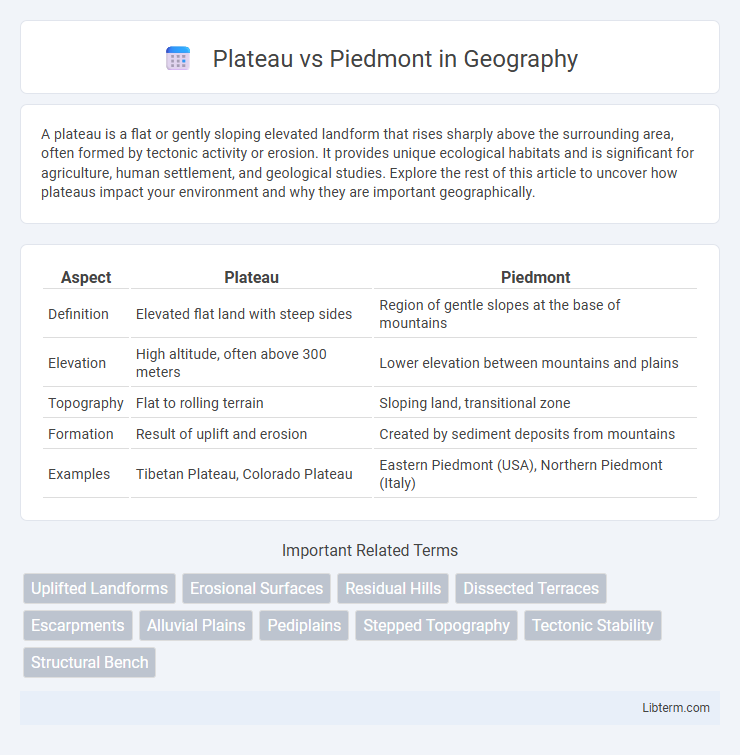A plateau is a flat or gently sloping elevated landform that rises sharply above the surrounding area, often formed by tectonic activity or erosion. It provides unique ecological habitats and is significant for agriculture, human settlement, and geological studies. Explore the rest of this article to uncover how plateaus impact your environment and why they are important geographically.
Table of Comparison
| Aspect | Plateau | Piedmont |
|---|---|---|
| Definition | Elevated flat land with steep sides | Region of gentle slopes at the base of mountains |
| Elevation | High altitude, often above 300 meters | Lower elevation between mountains and plains |
| Topography | Flat to rolling terrain | Sloping land, transitional zone |
| Formation | Result of uplift and erosion | Created by sediment deposits from mountains |
| Examples | Tibetan Plateau, Colorado Plateau | Eastern Piedmont (USA), Northern Piedmont (Italy) |
Introduction to Plateaus and Piedmonts
Plateaus are elevated flat-topped landforms rising sharply above surrounding terrain, often formed by tectonic uplift or volcanic activity, characterized by extensive horizontal strata and steep edges. Piedmont refers to the gentle slope region located at the base of mountains, formed by sediment deposition from eroding highlands, featuring rolling hills and fertile soils. Both landforms play crucial roles in regional ecology and human settlement patterns, with plateaus offering mineral resources and piedmont areas supporting agriculture due to rich alluvial deposits.
Defining Plateaus: Key Characteristics
Plateaus are elevated flatlands characterized by relatively uniform, horizontal or gently undulating surfaces that rise sharply above the surrounding terrain, often formed through tectonic uplift or volcanic activity. They exhibit distinct edges known as escarpments, which contrast with the more gradual slopes found in Piedmont regions. Unlike the rolling foothills of Piedmont, plateaus maintain extensive flat expanses at high elevation, making them key features in geomorphology and landscape studies.
Understanding Piedmonts: Main Features
Piedmont regions are characterized by gently rolling hills that lie between coastal plains and mountain ranges, often formed by sediment deposits from erosion. These landscapes feature fertile soils ideal for agriculture, moderate elevations ranging from 300 to 1,500 feet, and a network of rivers and streams that support diverse ecosystems. Unlike plateaus, which are flat elevated lands, piedmonts provide gradual transitions in topography and rich biodiversity crucial for both farming and residential development.
Formation Processes: Plateau vs Piedmont
Plateaus form primarily through volcanic activity or the uplift of large, flat-lying rock layers caused by tectonic forces, resulting in elevated flat terrains. Piedmonts develop through the gradual accumulation of sediments eroded from nearby mountains, typically forming gently sloping foothills at the base of mountain ranges. The distinct formation processes highlight plateaus as tectonically elevated landforms while piedmonts emerge from depositional and erosional dynamics.
Geographic Distribution and Examples
The Plateau region primarily spans elevated flat terrain such as the Colorado Plateau in the western United States and the Deccan Plateau in India, characterized by significant elevation and relative flatness. In contrast, the Piedmont lies at the foothills of mountains, like the Piedmont region along the eastern United States adjacent to the Appalachian Mountains, featuring gently rolling hills and gradual slopes. Geographic distribution distinguishes plateaus as broad, high-altitude plains, while piedmont areas serve as transitional zones between mountains and lowlands.
Climate and Vegetation Differences
The Plateau region experiences a cooler climate with higher precipitation, supporting dense forests of pine, oak, and hickory, while the Piedmont has a warmer, more temperate climate with moderate rainfall that sustains mixed hardwood forests and rich agricultural land. Vegetation in the Plateau is dominated by coniferous trees adapted to the cooler, moist conditions, whereas the Piedmont's vegetation includes a diverse mix of deciduous trees and shrubs thriving in well-drained soils. Climate differences drive variations in soil moisture and temperature, influencing distinct ecological zones and biodiversity between the two regions.
Human Settlements and Land Use
The Piedmont region's gently rolling hills and fertile soils support dense human settlements and intensive agriculture, including vineyards and orchards, fostering urban growth and industrial development. In contrast, the Plateau features rugged terrain with thin, rocky soils, leading to sparse settlements primarily focused on forestry, mining, and limited farming activities. Land use in the Piedmont emphasizes residential expansion and commercial farming, while the Plateau remains dominated by conservation areas and resource extraction industries.
Economic Importance and Resources
The Plateau region is rich in minerals and has significant mining activities, contributing substantially to the local economy through coal, iron ore, and other mineral extractions. The Piedmont area is an important agricultural zone known for its fertile soils, supporting diverse crops such as tobacco, soybeans, and corn, which drive regional agribusiness revenue. Both regions benefit from their natural resources, with the Plateau emphasizing mineral wealth and the Piedmont excelling in agricultural productivity.
Plateaus vs Piedmonts: Environmental Impact
Plateaus, characterized by elevated flat terrains, often influence local climates by altering wind patterns and precipitation distribution, impacting ecosystems distinctively from Piedmonts. Piedmonts, as gently sloping regions at the base of mountains, serve as crucial zones for sediment deposition and water runoff, affecting soil fertility and watershed dynamics. The environmental impact of plateaus includes potential habitat fragmentation and changes in vegetation due to altitude, whereas Piedmonts contribute significantly to biodiversity through transitional habitats and nutrient-rich soils.
Comparative Summary and Conclusion
The Plateau region features elevated flatlands with sedimentary rock formations, whereas the Piedmont consists of rolling hills composed mainly of metamorphic and igneous rocks. The Plateau's soil tends to be less fertile due to its rocky terrain, while the Piedmont supports more diverse agriculture owing to richer, weathered soils. In summary, the Plateau's landscape is characterized by flat highlands and limited farming potential, contrasting with the Piedmont's gently sloping hills and more productive agricultural conditions.
Plateau Infographic

 libterm.com
libterm.com